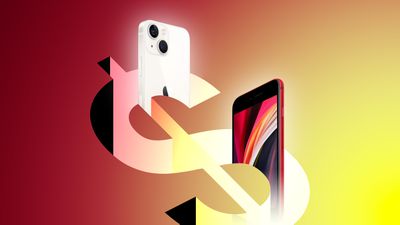The third-generation iPhone SE and the iPhone 13 mini are among Apple's smallest iPhone options. Apple released the iPhone 13 mini in late 2021, and bumped it down in price over time until 2023 when it discontinued the device. The slightly larger iPhone 13 continues to be available for $599. The third-generation iPhone SE launched in early 2022, refreshing the most affordable iPhone option in the lineup with a starting price of $429.

The iPhone 13 mini is still available from many third-party retailers, as well as second hand. With less than $170 between them, should you get the new, smaller, entry-level iPhone or the slightly older, all-screen model that has come down in price over time? Our guide helps to answer the question of how to decide which of these two iPhones is best for you.
| iPhone SE (third-generation) | iPhone 13 mini |
|---|---|
| Design of 2017's iPhone 8, featuring rounded edges, a Home button, and large bezels at the top and bottom of the display | Design based on 2020's iPhone 12 mini, featuring flat sides, diagonally arranged rear cameras, and an edge-to-edge display with a "notch" TrueDepth camera array for Face ID |
| Glass front and back | Ceramic Shield front and glass back |
| 4.7-inch Retina HD LCD display | 5.4-inch Super Retina XDR OLED display |
| 625 nits max brightness (typical) | 800 nits max brightness (typical) and 1,200 nits peak brightness (HDR) |
| 1400:1 contrast ratio (typical) | 2,000,000:1 contrast ratio (typical) |
| Touch ID | Face ID |
| 15-hour battery life (during video playback) | 17-hour battery life (during video playback) |
| Single rear camera | Dual rear cameras with 2x optical zoom range |
| 12-megapixel Main camera with ƒ/1.8 aperture | 12-megapixel Main camera with ƒ/1.6 aperture |
| 12-megapixel Ultra Wide camera with ƒ/2.4 aperture | |
| Optical image stabilization for video | Sensor-shift optical image stabilization for video |
| Night mode | |
| Cinematic mode for recording videos with shallow depth of field (1080p at 30 fps) | |
| HDR video recording with Dolby Vision up to 4K at 30 fps | |
| Audio zoom | |
| Front-facing 7MP FaceTime HD camera with 1080p HD video recording and Smart HDR 4 | Front-facing 12MP TrueDepth camera with 4K video recording, Smart HDR 4, slo-mo video support, Animoji, and Memoji |
| Rated IP67 water-resistant to a depth of one meter for up to 30 minutes | Rated IP68 water-resistant to a depth of six meters for up to 30 minutes |
| First-generation ultra wideband chip for spatial awareness | |
| Supports Dolby Atmos audio playback | |
| Compatible with MagSafe cases, wallets, wireless chargers, and more | |
| Available with 64GB, 128GB, or 256GB storage | Available with 128GB, 256GB, or 512GB storage |
| Midnight, Starlight, and PRODUCT(RED) color options | Green, Pink, Blue, Midnight, Starlight, and PRODUCT(RED) color options |
Overall, the iPhone SE is an excellent entry-level iPhone option for just $429. Some users may even value the more traditional design, Home Button, and size of the iPhone SE compared to the iPhone 13 mini.
For less than $170 more, the iPhone 13 mini offers a more modern design and a brighter, OLED display, as well as Face ID, an Ultra Wide camera, Cinematic mode, Night mode, considerably better front-facing and Main cameras, MagSafe, and longer battery life. There is also the benefit of improved water resistance, the ultra wideband chip, and Dolby Atmos audio playback, and even additional color options to choose from. All of this makes for a significant upgrade over the iPhone SE if you value these features and can afford the $170 extra, but it is worth bearing in mind that they are not essential capabilities for many users.
Overall, it comes down to whether you value having a smaller, newer device, or can look past this to get the benefits of a device with Face ID and a larger, OLED display. If you prefer the iPhone 13 mini's set of features, then it is still a good option, but generally most users looking for an affordable iPhone in this price range should opt for the iPhone SE.























